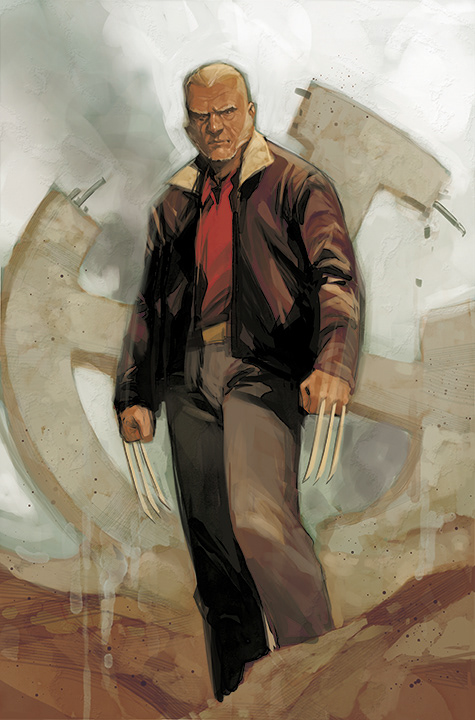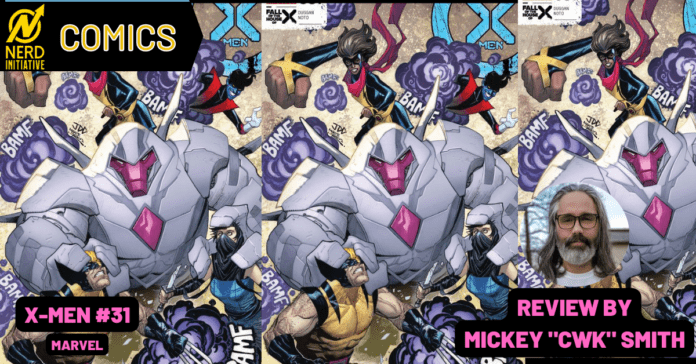Share this
We’re one step closer to the end of the Krakoan era of the X-Men. Synch is incapacitated, Orchis is holding human hostage via Krakoan medicine, and Nimrod is hunting down the last of the mutants. X-Men issue #31 feels a little bit like a filler episode at worst, and a transition for the next big step at best. Let’s dive a little deeper and talk about the good and the bad.

- Written By Gerry Duggan
- Art by Phil Noto
- Lettering by VC’s Clayton Cowles
- Designed by Tom Muller and Jay Bowen
“Though lovers be lost, love shall not; And death shall have no dominion.”
– Dylan Thomas from “And Death Shall Have No Dominion”
Let’s Get In Synch
In issue #30, Synch and Talon attempted to retrieve a weapon from The High Evolutionary. The weapon was designed to sterilize humanity, but the X-Men would need to reprogram it to negate the kill switch that Orchis had implanted in humans via the medicine Krakoa had been providing. The big reveal at the end of the issue was that Laura didn’t make it, and was only her consciousness survived through Synch’s use of Jean Grey’s power.
The problem with using a mutants power that isn’t near Synch, is that it takes a huge toll on his body, aging him rapidly. If he stops using Jean’s powers long enough to use someone’s healing powers, he’ll lose Laura forever.

Let Her Go, Synch
That’s where we find ourselves at the beginning of this issue. Synch is dying because he refuses to let Laura go. The X-Men need Synch if they are going to succeed the next step of their plan. All they can do is try their best to keep him alive until he can reconcile with the loss of Laura.
In the meantime, Ms. Marvel and Spider-Man try their best to deliver the antidote to everyone with the device Synch brought back. The problem? It alerts Nimrod to their location. Now the last of the X-Men must hold off the ultimate killing machine until the device finishes it’s job.
The Keys To The Comic
Love Lost Is Better Than Nothing Gained
The meat and potatoes of this issues writing takes place in the mind of Synch as he spends his final moments with Talon. Synch is refusing to give up the fight to keep Talon, Laura Kinney, in his mind, while fighting for his life in the real world. Laura understands that this is the end. She understands that Synch is needed in the fight against Orchis, and if he were to die here, like this, it would gain nothing for mutantkind.
There’s a great dynamic, and strong bond between the two of them that Gerry Duggan executes really well. In the real world, the story is straight forward. It’s all hands on deck vs Nimrod. Most of the dialogue is simple and reminds me of classic X-Men, bad guy quips vs good quips, dialogue.
We get one brief moment in which Kingpin, now the White King, is reunited with Typhoid Mary. It’s brief and feels almost out of place in this issue, but I assume it will have repercussions in future issues.

The Art Doesn’t Synch Up
I believe Phil Noto is a fantastic artist. I’m a fan. I say this so that you understand that I don’t have a bias here. The art of this book just falls flat. It feels rushed and simple. I know that every book doesn’t have to be a masterpiece, and there’s a place for this type of art in the world of comics, but it doesn’t fit here.
The colors are very plain, nothing pops out at me. The effects of light aren’t really present, which causes a lack of depth and detail.
On the other hand, facial expressions are great. I can see what Laura and Synch are feeling, even without reading the words they’re speaking. Kingpin and Nimrod shine above the rest in terms of looks. There’s also a great panel or two of Synch finally joining the fight and using Storm’s powers.
Everything Points To 6/10
As a regular reader of X-Men comics, this book really fell flat for me. While I was intrigued with the situation between Synch and Talon, I never really felt any suspense or high stakes for the the rest of the team. The back and forth between good guy and bad guy was stereotypical and it all felt predictable.
Artistically speaking, characters and colors were simple. To make things worse, the panel layout really made this drag. Simple blocks on every page, with wavy lines to represent moments in Synch’s mind. The whole thing felt rushed and nothing more than filler for the larger conclusion to come. Synch was definitely the star of this book and really established him as a cornerstone for what’s to come.


